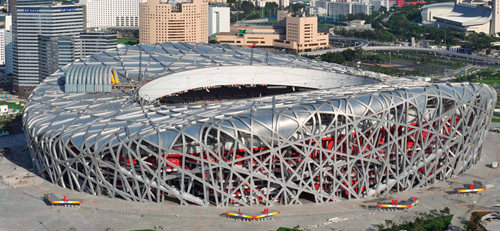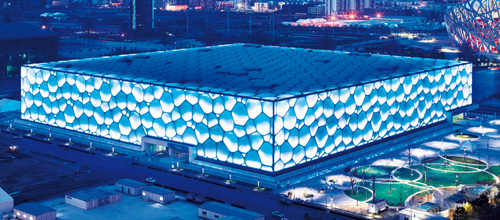National Olympic Stadium (Bird’s Nest) Of
all the buildings under construction in preparation for the Olympics,
the most striking is the new headquarters of China Central Television.
Designed by Dutch architect Rem Koolhaas, it is a gravity-defying loop
of horizontal and vertical sections. When completed it’s likely to
become one of the world’s most recognizable icons.

National Olympic Stadium
National Aquatics Center/Water Cube Inspired
by the formation of bubbles and molecules, the Water Cube is a complex
of five pools. Now that the Games are over, it will lose two-thirds of
its seats to make room for a multipurpose leisure center that will
include an artificial beach and water slides.

National Aquatics Center
National Indoor Stadium Built
to host gymnastics and handball during the 2008 Games, this stadium
boasts a sinuously curving roof with slatted beams, which is inspired by
traditional Chinese folding fans. Post-Olympics, the stadium will stage
entertainment events such as concerts. Olympic Green The
Olympic Green surrounds the Olympic Village and extends beyond the
fifth ring road, covering a total of 1,680 acres (680 hectares). At its
heart is a dragon-shaped lake, as well as waterfalls, meadows, and
streams. The park is slated for public use by 2009. Olympic Green Convention Center This
building hosted the fencing events during the 2008 Games, as well as
providing a home for the International Broadcasting Center. Its
distinctive shape mirrors the traditional Chinese “flying roof” and acts
as a giant rainwater collector. It is due to open as a conference venue
in July 2009. Digital Beijing Building Designed
by Beijing-based Studio Pei Zhu, Digital Beijing served as the Games’
Control and Data Center. It resembles a bar code from one side and an
integrated circuit board from the other. Post-Games, it will accommodate
a virtual museum and an exhibition center. Beijing Airport, Terminal 3 The
world’s largest and most advanced airport building, Lord Norman
Foster’s new Terminal 3 welcomed athletes from around the world to the
2008 Olympics. The design resembles a soaring dragon in red and yellow,
thus evoking traditional Chinese colors and symbols. National Grand Theater (National Center for the Performing Arts) French architect Paul Andreu’s silvery “Egg” provides a striking contrast to the monolithic, slab-like Socialist
architecture of neighboring Tian’an Men Square. The building is
surrounded by a reflective moat and accessed by an underwater tunnel. At
night, a part of the facade is transparent, so passers-by can see
what’s going on inside. CCTV Building The
most striking addition to the Beijing skyline is the new headquarters
of China Central Television. Designed by Dutch architects Rem Koolhaas
and Ole van Scheeren, it is a gravity-defying loop that pushes the
limits of architecture and reinvents the organization of spaces. When
completed, in 2009, it’s sure to become one of the world’s most
recognizable buildings. Television Cultural Center (TVCC) The
most striking addition to the Beijing skyline is the new headquarters
of China Central Television. Designed by Dutch architects Rem Koolhaas
and Ole van Scheeren, it is a gravity-defying loop that pushes the
limits of architecture and reinvents the organization of spaces. When
completed, in 2009, it’s sure to become one of the world’s most
recognizable buildings.
Top 10 Socialist Monuments
Agricultural Exhibition Center In
1959 to celebrate the tenth anniversary of the People’s Republic of
China, this was one of ten “key” buildings commissioned in “modern”
Chinese style. Great Hall of the People Over 300 rooms large, yet built in only 10 months. China National Museum Every bit as brutal and ugly as the Great Hall, which it faces across the square. Beijing Railway Station Prime illustration of 1959’s prevailing “size is everything” approach to architecture. Cultural Palace of the Nationalities The one “tenth anniversary” building of elegance. Its plan forms the Chinese character for “mountain.” Minzu Hotel No Chinese motifs – but suitably monolithic and drab. Chinese Military History Museum Owes a striking debt to Moscow. Natural History Museum Neo-Classical Socialist Chinese – but nice inside. National Art Museum of China The largest art gallery in China. Beijing West Railway Station 1995 update on 1959-style architecture.
|